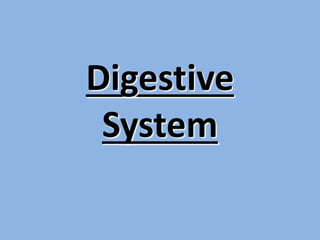Digestive System PPT.pptnkjnjknklnlknlnll
- 2. Digestion ? Phases Include 1. Ingestion 2. Movement 3. Mechanical and Chemical Digestion 4. Absorption 5. Elimination
- 3. Digestion ? Types ¨C Mechanical (physical) ? Chew ? Tear ? Grind ? Mash ? Mix ¨C Chemical ? Enzymatic reactions to improve digestion of ¨C Carbohydrates ¨C Proteins ¨C Lipids
- 4. Digestive System Organization ? Gastrointestinal (Gl) tract ¨C Tube within a tube ¨C Direct link/path between organs ¨C Structures ? Mouth ? Pharynx ? Esophagus ? Stomach ? Small intestine ? Large Intestine ? Rectum 4
- 5. Mouth ? Teeth mechanically break down food into small pieces. Tongue mixes food with saliva (contains amylase, which helps break down starch). ? Epiglottis is a flap-like structure at the back of the throat that closes over the trachea preventing food from entering it. It is located in the Pharynx.
- 6. Esophagus ? Approximately 20 cm long. ? Functions include: 1. Secrete mucus 2. Moves food from the throat to the stomach using muscle movement called peristalsis ? If acid from the stomach gets in here thatˇŻs heartburn. Mouth, Pharynx and Esophagus Video
- 7. Stomach 7 ? J-shaped muscular bag that stores the food you eat, breaks it down into tiny pieces. ? Mixes food with Digestive Juices that contain enzymes to break down Proteins and Lipids. ? Acid (HCl) in the stomach Kills Bacteria. ? Food found in the stomach is called Chyme.
- 8. Small Intestine ? Small intestines are roughly 7 meters long ? Lining of intestine walls has finger-like projections called villi, to increase surface area. ? The villi are covered in microvilli which further increases surface area for absorption. 8 Crash Course Review
- 9. Small Intestine ? Nutrients from the food pass into the bloodstream through the small intestine walls. ? Absorbs: ¨C 80% ingested water ¨C Vitamins ¨C Minerals ¨C Carbohydrates ¨C Proteins ¨C Lipids ? Secretes digestive enzymes 9
- 10. Large Intestine ? About 1.5 meters long ? Accepts what small intestines donˇŻt absorb ? Rectum (short term storage which holds feces before it is expelled).
- 11. Large Intestine ? Functions ¨C Bacterial digestion ? Ferment carbohydrates ¨C Absorbs more water ¨C Concentrate wastes
- 12. Accessory Organs The Glands ? Not part of the path of food, but play a critical role. ? Include: Liver, gall bladder, and pancreas
- 13. Liver ? Directly affects digestion by producing bile ¨C Bile helps digest fat ? filters out toxins and waste including drugs and alcohol and poisons. 13
- 14. Gall Bladder ? Stores bile from the liver, releases it into the small intestine. ? Fatty diets can cause gallstones
- 15. Pancreas ? Produces digestive enzymes to digest fats, carbohydrates and proteins ? Regulates blood sugar by producing insulin Web Page Reinforcement Video
- 17. On a sheet of paper, write the name of each colored organ: ? Green: ? Red: ? Pink: ? Brown: ? Purple: ? Green: ? Yellow:
- 18. HowˇŻd you do? ? Green: Esophagus ? Red: Stomach ? Pink: Small Intestine ? Brown: Large Intestine ? Purple: Liver ? Green: Gall Bladder ? Yellow: Pancreas Great Job!
- 19. References and Links ? Your Digestive System and How It Works ¨C Digestive system diagram comes from this site ? The Real Deal on the Digestive System ? Pancreas: Introduction and Index ? Your Gross and Cool Body - Digestive System ? Laurentian Regional High School Data Base - you must know the Username and Password


















